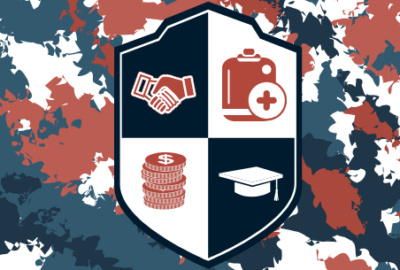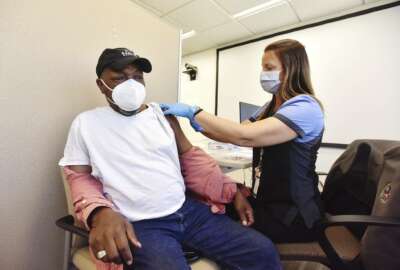Virtual reality comes to the Veterans Health Administration and its patients
VHA's Innovation Ecosystem has teamed up with a vendor called Wellovate to develop immersion therapies for patients.
Best listening experience is on Chrome, Firefox or Safari. Subscribe to Federal Drive’s daily audio interviews on Apple Podcasts or PodcastOne.
For the Veterans Health Administration, virtual reality isn’t about fun and games. Its patients have seen real war in real life. Instead, the VHA’s Innovation Ecosystem has teamed up with a vendor called Wellovate to develop immersion therapies for patients. They’ve been testing the system since August and Federal Drive with Tom Temin spoke to Caitlin Rawlins, VHA innovation specialist, and Allison Amrhein, the director of Operations for the VHA Innovators Network.
Interview transcript:
Tom Temin: And just set the scene for us – where in the vast hierarchy of VHA, does this program live? You’ve got a special kind of innovation unit it sounds like?
Allison Amrhein: Yes, that’s correct. So the VHA Innovation Ecosystem lives with the Office of Research and Development, with the Office of Academic affiliations. It’s kind of in its own hierarchy. And it’s really focused on serving as the catalyst for enabling and spreading mission driven healthcare innovation, to advance care delivery, create new models of care and service, and allow for growth through innovation. And the virtual reality world, through the Ecosystem has really exploded and expanded in such a short time – it’s amazing.
Tom Temin: And you’ve got a corporate partner to help develop these programs?
Allison Amrhein: So I’m going to defer to Caitlin because I know that there’s a number of them, not just quite the one. Caitlin will give a good landscape.
Tom Temin: All right, Caitlin?
Caitlin Rawlins: So we’ve actually been using Wellovate software with veterans since 2018. When I started that program, it was the only one within the VHA. But since that time, there are now over 100 VA’s utilizing extended reality technology, primarily virtual reality. And the number of collaborators is way more than one. And through the VHA extended reality network, also located underneath the Innovation Ecosystem, we try to help bring those collaborators to frontline employees to be able to test, pilot virtual reality software for different use cases across multiple veteran population. So there are way more collaborations than one at this point.
Tom Temin: Okay, then let’s talk about the one that started on Aug. 17. You launched a Innovation Ecosystem, groundbreaking initiative in VHA’s words and what’s going on there?
Caitlin Rawlins: Sure. So that is using the Wellovate platforms. Like I said, we’ve actually been working with them since 2018 but this particular collaboration is a 12-site quality improvement, collaboration, looking at six different use cases, with multiple veteran populations across the country. It will be a two-year collaboration that allows, like I said, these frontline employees to kind of pilot and determine the feasibility of utilizing this technology with those populations, in an effort to help with pain management, anxiety management, palliative care, fall risk assessments, neurological assessments. And just recently, we used virtual reality in the operating room for the very first time on VHA.
Tom Temin: And Allison, what does this take to make sure that the powers that be, the directors of the medical centers and so forth, have the metrics they need to make sure that they can buy into the program and know that you’re not doing odd experiments on their veterans?
Allison Amrhein: The first thing that is looked at and taken into account is the direct feedback from veterans. So with the Innovation Ecosystem, and the the Innovators Network, which is what Caitlin and I are part of, it is all about the veteran and solving a problem. And what has been found is that the VR does this. And we provided a space for outside of the day-to-day operations of the medical center to experiment in a safe and kind of fun way for employees and veterans. And that’s what it started as. And supporting that, seeing the feedback, seeing the response from veterans – it’s a trickle-down effect. And it doesn’t take a lot to make leadership perk up when veterans are having such a positive response to something.
Tom Temin: We’re speaking with Allison Amrhein, she’s director of operations for the Innovators Network. And with Caitlin Rawlins – she’s an innovation specialist, both with the Veterans Health Administration. And Caitlin, let’s get into some of the details. What is a use case? I see a picture of a veteran lying in a bed who had knee surgery, and there’s a virtual reality mask on his face. What’s going on?
Caitlin Rawlins: Well, like I said, we use multiple different VR software platforms. That particular one that veteran was using, he was looking at basically a nature scene and virtual reality. So a computer generated environment that was allowing him to walk through the woods to climb rocks to sit by a campfire, listening to all the sounds of nature, there was animals there. So it really takes veterans outside of the four walls of their hospital room to allow them to experience positive distraction and as we know for things like pain and anxiety if you can distract a veteran from that, even temporarily, you’re basically putting their brain on something else. And it works incredibly well for all of the things that we’ve tried to use it for thus far.
Tom Temin: Just out of curiosity, what happens when you eventually have to take off the mask?
Caitlin Rawlins: Well, that’s one thing that we’re still researching and not just within the VHA. So there’s very little literature out there so far related to the sustained effect of virtual reality. And it really depends on the use case. So for something like acute pain, there may be a prolonged effect where they are distracted and kind of more at peace for a longer period of time. For something like chronic pain, their chronic pain may return quite quickly. But for some of these chronic pain patients with veteran populations, even 30 minutes without feeling their pain is a significant achievement. Because if they’ve been living with pain for 20 years, and we can all of a sudden take that away. It’s pretty monumental. And I’ve seen some wonderful reactions from our veterans. We’ve collected at this point over 300 veteran statements about their experience with virtual reality, and has been overwhelmingly positive.
Tom Temin: I guess it’s better than putting a tray of slides into the carousel and pretending you’re looking at nature. But what about some of the more kinetic applications because when you think of VR, you think of these games where people are running and throwing things and shooting things at each other. Is there a motion PT-type of physical therapy aspect to this, that’s possible?
Caitlin Rawlins: It is definitely possible. And that’s been one of the emerging use cases within the VHA is for physical and occupational therapy, in addition to pain management. And a lot of those platforms are actually FDA approved programs. So physical therapists and occupational therapists can see on the back end all of the actual measurement data that they would normally be collecting themselves. And patients are able to do it in kind of a gamified environment, making that experience a more positive and interactive one. We’re looking at right now utilizing that with veterans actually in their homes. So doing it via remote care and telehealth, which I think is really going to change the way we’re able to do remote care and make it a more immersive and pleasant experience.
Tom Temin: It sounds like it could have sort of dual use, because you can get a better maybe motion for someone in a controlled environment like that. And at the same time, if the PT is causing pain, like after knee replacement, for example, it’s better to be looking at the mountain streams and lakes than at the kitchen sink you’re actually leaning on.
Caitlin Rawlins: Absolutely. One of the VR platforms that we’re looking at for PT and OT, for instance, while they’re collecting range of motion data on cervical spine and upper extremities, they’re actually in a game that looks like a medieval world with dragons flying around and trying to protect a dragon from the city or something like that. So they’re completely distracted from the pain that they’re experiencing. And I think that’s where a lot of that potential lies. So that, we know that physical and occupational therapy, as you said, can be very painful. And so if we can make that a more enjoyable experience, somehow, whether that’s on site, like in the hospital or at their homes, I think that we’re being successful.
Tom Temin: I’m gonna have to try it with my hamstring that’s been so active these past couple of months. And Allison, what kinds of data what kinds of record keeping is being amassed here? To get some sense of the efficacy of the program as a whole?
Allison Amrhein: I will also defer to Caitlin on that, because she will know definitely more than I do. I can say that one advantage of having an organization within VHA, like the Innovation Ecosystem is our ability to collectively come together to form new networks and new groups of folks working throughout our giant system towards the same goal using the same types of treatments, etc., in this case, VR. And it allows for data collection and collaboration and achieving the goal of kind of collecting information much easier. And that’s a huge plus of having an ecosystem that’s focused on innovation. But I will defer to Caitlin to give you the numbers because she will have some numbers for you.
Tom Temin: Yes, so you stand outside the patient with the mask on with a clipboard, I imagined, checking boxes and taking notes, Caitlin?
Caitlin Rawlins: No usually I’m just being entertained by their their reaction to virtual reality to be perfectly honest. But a lot of the data that we collect, we do pre and post testing. So it may be vital signs, pain scores, anxiety scores, behavioral rating, whatever it might be. So we do that pre and post and collect that data, especially locally in western North Carolina, as part of the VHA extended reality network. As I said, that’s a much larger group that grew out of a very small community of practice. Initially, that only had about 12 people and now we have over 400 that partake in that community of practice. And one of our goals in that is to help standardize some of the outcome data that we’re collecting. So as one of the largest, if not the largest integrated health care systems, we want to make sure that the data we’re collecting, utilizing this innovative technology, that we’re collecting a lot of the same stuff so that across the board, we can see the efficacy of it for multiple use cases. But we do collect data, and it has been overwhelmingly positive. So, if I’ve used it locally with over 350 patients, out of those, almost 70% of them experienced a decrease in pain using only virtual reality, or 92% of them had a decrease in anxiety levels. And I think, another important piece of that, like I said, are those veteran statements that we collect about their actual experience, and that’s where you get those candid remarks. Like, I didn’t even think about my pain while I was using that, or it took away my anxiety completely, or my favorite are like the food-related ones, like better than sliced bread or icing on the cake of my stay here. Those are the comments that we look for. And I think those speak volumes, more so than any of the quantitative data that we can possibly collect.
Tom Temin: And a final question, is this all still considered pilot type of medicine, and is it on route to becoming established regular procedures?
Caitlin Rawlins: It is considered pilots at this point still. Like the program that I created in Asheville is further along than a lot of other sides. So it definitely is kind of becoming integrated with the care that we already deliver. But across the VHA as a whole, it’s still very much kind of in pilot status, with a relatively soon future goal of making it something that is diffused out to other sites across the board. My project was selected as the director’s pick for Shark Tank this year, during iEX [VHA Innovation Experience]. And the goal of that, if I end up spreading the project is to diffuse it more broadly throughout the VHA. So even if it is still semi in pilot status, it is something that is absolutely gaining ground. And I think within the next couple of years, we will see it being rolled out as more of a standard of care.
Tom Temin: And while we have you tell us about the event connected to this, where you’re kind of demonstrating this for the world.
Caitlin Rawlins: Allison, I don’t know if you want to explain that a little bit more?
Allison Amrhein: So the Innovation Experience is VHA’s innovation conference of the year, you can say. But we do prefer the word “experience,” because you will get to experience first-hand accounts from people like Caitlin who have innovated the care model of VA and their experience with how they did that and how it was successful, why it was successful. So you get to hear from frontline employees who are innovating and changing the care at VA for veterans, as well as collaborators that we’re working with to do this work together. Everything is, of course better together, we’re able to accomplish more with diverse perspectives. This year’s event, also very excited that Secretary [Denis] McDonough will be there to give remarks on the first day highlighting the importance of innovation of VA. And we have just a number of really creative and fun experiences for those who attend.
Tom Temin: And this takes place when and where?
Allison Amrhein: So this takes place Oct. 27th and 28th. And it will be completely virtual, and it’s being broadcast from the National Press Club. It is usually a face-to face-experience. But pandemic life still reigns so you can still register for the event and it is completely open to the public, even.
Tom Temin: Online, you can have casts of thousands. Allison Amrhein is director of operations for the Innovators Network. And Caitlin Rawlins is an innovation specialist both at the Veterans Health Administration. Thanks so much for joining me.
Caitlin Rawlins: Thank you for having us.
Allison Amrhein: Thank you so much.
Copyright © 2025 Federal News Network. All rights reserved. This website is not intended for users located within the European Economic Area.
Tom Temin is host of the Federal Drive and has been providing insight on federal technology and management issues for more than 30 years.
Follow @tteminWFED






